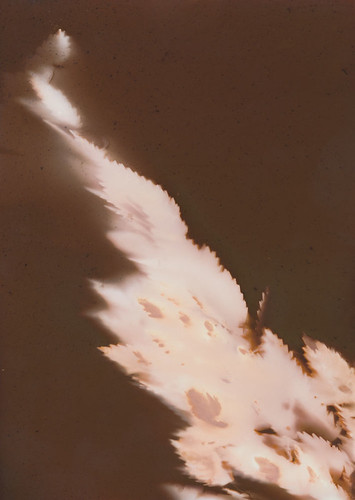 |
| 4 hours, regular water |
 |
| 2 hours, basic water |
 |
| 2 hours, acidic water |
I have previously experimented with exposing lumens in water. Often a paper has totally different characteristics when exposed to moisture, so lumens made in water will tend to display a radically different color scheme than normal. Since both the paper and the printing object are floating in water, contact is limited and the images are blurry, sometimes very blurry if the paper or object are disturbed in the water. Debris can get into the water, moving around and creating interesting background results. The water adds another dimension to the printing process.
Over the last few days, I decided to try something else. I already knew from
other experiments (and just basic darkroom chemistry) that photographic paper reacts not only to moisture, but also to acids and bases. Developer, for example, is basic. Stop bath is acidic. I once tried painting liquid detergent (a strong base) onto photopaper, only have to it turn black within seconds. I knew ahead of time that by adding acids or bases to the paper, I could influence how it developed. So, I mixed up some solutions and exposed lumen prints in either a slightly acidic solution, or a slightly basic solution.
My base solution was just a simple addition of baking soda to hot water. I dissolved the soda completely, though I do plan to do some later tests with larger amounts to see what it does when large amounts are in direct contact with the paper. From these preliminary tests, I found that (as expected) the baking soda solution seems to accelerate the exposure. Normally the paper tested, Fomalux RC Contact Paper, shifts from violet to green over the course of 4-5 hours if exposed underwater. When immersed in the baking soda solution, that time was cut in half. I got a full conversion to the desired orange-green scheme in just under 2 hours. Normally a 2 hour exposure in water is just brown. I'm going to experiment with this to speed up other long-exposure papers like Collodio POP and Harman Direct Positive.
For the acid solution, I used anhydrous citric acid crystals, which I did not fully dissolve. In one test, I sprinkled the crystals directly onto the paper. No significant results, but the areas of contact did show some minor resistance to exposure. In general, the acidic environment did as expected and slowed exposure considerably. The Fomalux paper, after 2 hours, was a dull brown with very little contrast. It seems to affect the background more strongly than the object (possibly not as much acid reaching the paper where it was covered by the object?) because the object was turning orange already while the rest of the paper was still brown.
I'll be trying with some other solutions and concentrations, but I think this technique (especially the basic solution) has some interesting potential. Speeding or slowing chemical exposure of lumens could allow for some fun play with papers that normally expose too fast or too slow. I need to see if I can produce the results without submerging the prints, possibly by pre-soaking the paper. That would allow more traditional, full-contact lumens. That'd be nice; I like detail.
No comments:
Post a Comment